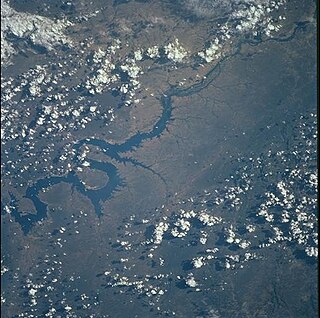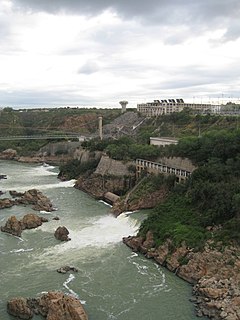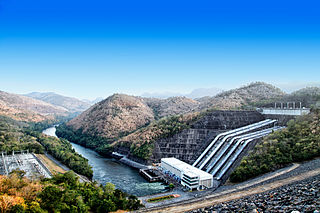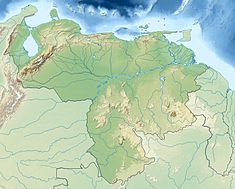The Shoalhaven Scheme is a dual-purpose water supply and Pumped-storage Hydroelectricity scheme located on the South Coast region of New South Wales, Australia.

The Guangdong Pumped Storage Power Station or Guangzhou Pumped Storage Power Station is a pumped-storage hydroelectric power station near Guangzhou, Guangdong Province, China. Power is generated by utilizing eight turbines, each with a 300 megawatts (400,000 hp) capacity, totalling the installed capacity to 2,400 megawatts (3,200,000 hp). The generated power is sold to China Light and Power customers in Hong Kong. The power station was constructed in two stages, the first four turbines were completed in 1994 and the second four in 2000.

The Caruachi Dam is a concrete gravity dam on the Caroní River in Bolivar state, Venezuela. It supports a hydroelectric power facility with a 2,160 megawatts (2,900,000 hp) capacity. It is about 59 kilometres (37 mi) downstream from the Guri Dam belonging to the Central Hidroeléctrica Simón Bolívar, and about 35 kilometres (22 mi) from where the Caroni and Orinoco rivers meet at Ciudad Guayana.

Richard B. Russell Dam is a concrete-gravity and embankment dam located on the Savannah River at the border of South Carolina and Georgia, creating Richard B. Russell Lake. The dam was built by the U.S. Army Corps of Engineers between 1974 and 1985 for the purposes of flood control, hydroelectricity, recreation, additional stream flow regulation, water supply, and fish and wildlife management. The concrete structure of the dam spans 1,904 feet (580 m) and rises 210 feet (64 m) above the riverbed, housing a hydro-power plant with an installed 600 megawatts (800,000 hp) capacity. The Richard B. Russell Dam is the final large dam completed by the U.S. Army Corps in the Savannah River Basin and lies 30 miles downstream from the Hartwell Dam (1962) and 37 miles (60 km) upstream from the J. Strom Thurmond Dam (1954).

The Ilha Solteira Dam is an embankment dam on the Paraná River near Ilha Solteira in São Paulo, Brazil. It was constructed between 1967 and 1973 for hydroelectric power production, flood control and navigation.

The Luiz Gonzaga Dam, formerly known as the Itaparica Dam, is a rock-fill embankment dam on the São Francisco River 25 kilometres (16 mi) downstream of Petrolândia in Pernambuco, Brazil. The dam was built for navigation, and hydroelectric power generation as it supports a 1,479 megawatts (1,983,000 hp) power station. It was constructed between 1979 and 1988; the last of its generators was commissioned in 1990.

The Paulo Afonso Hydroelectric Complex, also known as the Paulo Afonso Complex, is a system of three dams and five hydroelectric power plants on the São Francisco River near the city of Paulo Afonso in Bahia, Brazil. The complex exploits an 80-metre (260 ft) natural gap on the river, known as the Paulo Afonso Falls. Constructed in succession between 1948 and 1979, the dams support the Paulo Afonso I, II, III, IV and Apollonius Sales (Moxotó) power plants which contain a total of 23 generators with an installed capacity of 4,279.6 megawatts (5,739,000 hp).

The Governor José Richa Hydroelectric Plant, formerly known as Salto Caxias, is a dam and hydroelectric power plant on the Iguazu River near Caxias in Paraná, Brazil. It is the first dam upstream of the Iguazu Falls and was constructed between 1995 and 1999. The power station has a 1,240-megawatt (1,660,000 hp) capacity and is supplied with water by a roller-compacted concrete gravity dam.

The Itá Hydroelectric Power Plant is a dam and hydroelectric power plant on the Uruguay River near Itá on the border of Santa Catarina and Rio Grande do Sul, Brazil. The power station has a 1,450-megawatt (1,940,000 hp) capacity and is supplied with water by a concrete face rock-fill embankment dam. It is owned and operated by Tractebel Energia and produces the equivalent of 60% of the energy consumed in Santa Catarina.
The Machadinho Hydroelectric Power Plant is a dam and hydroelectric power plant on the Pelotas River near Machadinho on the border of Santa Catarina and Rio Grande do Sul, Brazil. The power station has a 1,140 MW (1,530,000 hp) capacity and is supplied with water by a concrete face rock-fill embankment dam. It is owned and operated by Machadinho Energetica and produces the equivalent of 37% of the energy consumed in Santa Catarina.
The Serra da Mesa Dam, once known as Sao Felix, is an embankment dam on the Tocantins River near Minaçu in Goiás, Brazil. The dam serves an associated hydroelectric power plant with a 1,275 megawatts (1,710,000 hp) installed capacity. The dam creates the largest reservoir by volume in Brazil.

The Marimbondo Dam is an embankment dam on the Grande River near Fronteira in Minas Gerais, Brazil. The dam serves an associated hydroelectric power plant with a 1,440 megawatts (1,930,000 hp) installed capacity.
The São Simão Dam is an embankment dam on the Paranaíba River near São Simão in Goiás/Minas Gerais, Brazil. It was constructed for hydroelectric power production and flood control. The dam was completed in 1978 and all generators were operational by 1979. In 1977, the first use of roller compacted concrete in Brazilian dam construction occurred on the São Simão.
The Três Marias Dam, also known as Bernardo Mascarenhas, is an embankment dam on the São Francisco River near Três Marias in Minas Gerais, Brazil. It was constructed for hydroelectric power production and flood control. The dam was completed in 1961 and its first generator was operational in 1962. The dam's power plant is named after Bernard Mascarenhas who in 1889, built South America's first major hydroelectric power plant in Brazil, the Marmelos Zero Power Plant.

Al Wahda Dam, formerly known as M'Jaara Dam, is an embankment dam on the Ouergha River near M´Jaara in Taounate Province, Morocco. It was constructed for flood control, irrigation, water supply and hydroelectric power production. It is the second largest dam in Africa and the largest in Morocco. It was described by Land Ocean Interactions in the Coastal Zone (LOICZ) as "the second most important dam in Africa after the High Aswan dam."

The Srinagarind Dam is an embankment dam on the Khwae Yai River in Si Sawat District of Kanchanaburi Province, Thailand. The purposes of the dam are river regulation and hydroelectric power generation. The dam's power station has a 720 megawatts (970,000 hp) capacity of which 360 megawatts (480,000 hp) is pumped storage. The dam was named after Princess Srinagarindra.
The Punchiná Dam is an embankment dam on the Guatapé River 17 kilometres (11 mi) east of San Carlos in Antioquia Department, Colombia. The dam creates Punchiná Reservoir which is part of the 1,240 megawatts (1,660,000 hp) San Carlos Hydroelectric Power Plant. The power plant was completed in two 620 megawatts (830,000 hp) stages, the first was completed in 1984 and the second in 1987. It is the largest power station in Colombia.
The Dniester Pumped Storage Power Station is a pumped storage hydroelectric scheme that uses the Dniester River 8 kilometres (5.0 mi) northeast of Sokyriany in Chernivtsi Oblast, Ukraine. Currently, four of seven 324-megawatt (434,000 hp) generators are operational and when complete in 2028, the power station will have an installed capacity of 2,268 megawatts (3,041,000 hp).

The Shin-Takasegawa Pumped Storage Station (新高瀬川発電所) uses the Takase River to operate a pumped storage hydroelectric scheme about 12 kilometres (7.5 mi) west of Ōmachi in Nagano Prefecture, Japan. Part of the system is within Chūbu-Sangaku National Park.

The Rocky Mountain Hydroelectric Plant is a pumped-storage power plant located 10 miles (16 km) northwest of Rome in the U.S. state of Georgia. It is named after Rock Mountain on top of which the plant's upper reservoir is located. Construction on the plant began in 1977 and it was commissioned in 1995. After upgrades were completed in 2011, the plant has an installed capacity of 1,095 megawatts (1,468,000 hp). It is owned by both Oglethorpe Power and Georgia Power which have 75 percent and 25 percent stakes, respectively.















